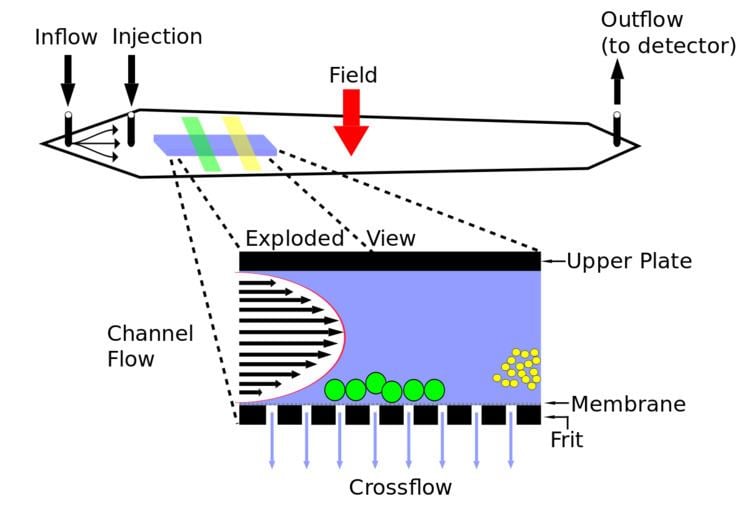 | ||
Asymmetrical flow field-flow fractionation (AF4) is a fractionation method that is used for the characterization of nanoparticles, polymers and proteins. The theory for AF4 was conceived in 1986 and was established in 1987. It is a separation technique based on the theory of field flow fractionation (FFF). AF4 is distinct from FFF because it contains only one permeable wall so the cross-flow is caused only by the carrier liquid. The cross-flow is induced by the carrier liquid constantly exiting by way of the semi-permeable wall on the bottom of the channel. It has been used to characterize condensed tannins oxidation.
Contents
Operational procedures
The AF4 experiment can be separated into three stages:
1. Sample Injection
Samples are injected into the system using a known amount of sample volume. This volume will depend on the AF4 instrument being utilized in the experiment. Starting fractionation immediately after sample injection is not ideal because the sample is going to spread out randomly from the injection site, so the beginning velocity and place of the particles are not all the same. This leads to line broadening and insufficiency. In order to correct such an error, sample focusing is proposed. Modern AF4 Systems allow both: manual and auto injection.2. Sample focusing
3. Fractionation
Modern systems are using pumps instead of flow controllers to provide constant flow rates in a wide flow range with minimum of tubing and a metal free sample path.
Applications
Asymmetrical flow field flow fractionation (AF4) is nowadays a common and state-of-the art method for fractionation and separation of macromolecules and particles in a suspension. More commonly, HPLC would be used for liquid separations for molecules up to 10 kDa and nanoparticles up to 10 nm. AF4's application are flexible for many analytical conditions where a common method would be unable to properly separate the desired particles. For macromolecules and nanoparticles AF4 is an alternative method especially when the static phase in columns creating interaction with the sample. It has also been used to study aggregation of particles in a solution.
